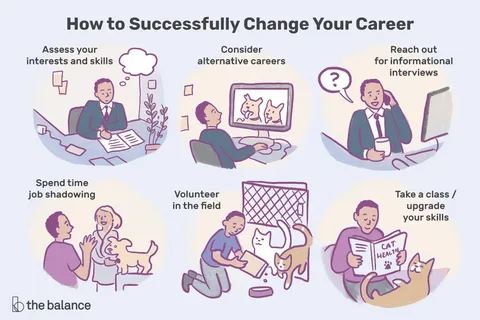Introduction
Making a career change can be both exciting and daunting. Whether you’re seeking new challenges, better work-life balance, or following a long-held passion, a successful career transition requires careful planning and execution. In this guide, we’ll walk you through the essential steps to make your career change a success. If you’re still in the early stages of considering a change, our article on choosing the right career path can help you evaluate your options.
Assessing Your Readiness for Change
Before making a career change, it’s crucial to assess your readiness and motivations. Research from the Bureau of Labor Statistics shows that most workers change careers multiple times throughout their lives. Start by evaluating your current situation and identifying what you want from your new career. This process is similar to the career planning approach we discussed earlier, but with a focus on transition rather than progression.
Identifying Transferable Skills
One of the most important steps in changing careers is identifying your transferable skills. These are abilities that can be applied across different industries and roles. For example, project management, communication, and problem-solving skills are valuable in almost any field. To develop a comprehensive understanding of your skills, consider using tools like the O*NET Skills Search. This will help you identify which of your current skills can be leveraged in your new career path.
Building New Skills and Knowledge
While transferable skills are important, you’ll likely need to develop new skills specific to your target industry. This might involve taking courses, earning certifications, or gaining practical experience through volunteering or side projects. Our guide on essential skills for career advancement can help you identify which skills to prioritize. Remember, continuous learning is key to staying relevant in today’s job market.
Networking and Making Connections
Building a strong network in your target industry is crucial for a successful career change. Start by connecting with professionals in your desired field through platforms like LinkedIn or industry events. Our article on building a strong professional network provides detailed strategies for making meaningful connections. These connections can provide valuable insights, job leads, and even mentorship opportunities.
Managing the Transition
The actual transition to your new career requires careful planning and execution. Consider starting with a part-time role or freelance work in your new field while maintaining your current job. This approach, known as “career bridging,” can help you gain experience while maintaining financial stability. For more strategies on managing workplace transitions, check out our article on succeeding in your first 90 days at a new job.
Conclusion
Making a successful career change is a journey that requires preparation, patience, and persistence. By following these steps and leveraging the resources available to you, you can make a smooth transition to a more fulfilling career. Remember that career changes often involve some degree of risk, but with proper planning and execution, the rewards can be well worth it.
Frequently Asked Questions
Q: How long does a career change typically take?
A: The timeline for a career change varies depending on factors like your target industry, required qualifications, and current situation. Some transitions can take a few months, while others might require a year or more of preparation. The key is to be patient and thorough in your preparation.
Q: Should I quit my current job before finding a new one?
A: It’s generally advisable to maintain your current job while preparing for your career change. This provides financial stability and allows you to make the transition on your own terms. However, there may be exceptions depending on your specific circumstances.
Q: How can I explain my career change to potential employers?
A: Frame your career change as a positive, intentional decision that aligns with your long-term goals. Highlight your transferable skills and any relevant experience or training you’ve acquired. Be prepared to explain how your previous experience will benefit you in the new role.

